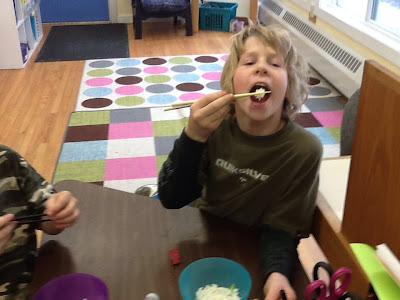
When I first explained what a nori roll is to my class, reactions varied. Some kids have eaten it; one has even prepared it at home. But most couldn't understand why you'd want to wrap up anything in dried seaweed and then eat it. For the skeptical, it didn't help that the kids who have been already been initiated to the wonders of Japanese cuisine were salivating. I stressed that our cooking day would be a chance for everyone to see something new and make some choices about what they tasted: just the rice, a piece of the toasted seaweed, or maybe they'd go whole hog with wasabi in their soy sauce and pickled ginger on the side. Secretly, I imagined the entire class eating nori and raving about how cool it was.
We had just read a passage about California cuisine. It ended by saying that many diners first eat California rolls before trying more exotic Japanese dishes. For me this was certainly the case. Years back, I remember being very comfortable eating nori but thinking raw fish was NOT for me. Then I found myself at a Japanese restaurant with a friend. He tucked into a plate of sushi like nobody's business. Eventually I was offered one piece and tried it. From there I was hooked. California rolls may well be the gateway food to the love affair many of us have with sushi.
On the budgeting front, the good news is that I found sushi nori at a much better price at the second grocery store I checked, so I had enough for everyone to make a roll plus extra for sampling. When offered, most kids tried a small plain piece of it. Unfortunately, because a few didn't like the taste of that, they declined making or tasting a roll. Although the project went smoothly and many kids ate and tried something new, at first I was a bit surprised/disappointed. Several kids never even tasted one piece of nori. It's taken me a day of reflection on this food adventure to fully appreciate that this dish was way far out of some kids' comfort zone. One student almost seemed offended when asked to watch my demonstration of how to roll the nori.
In the end, about two thirds of the class made a roll and chose from carrot, cucumber, avocado and smoked salmon for their fillings.
I overheard one student talking to his friend say something along the lines of, “Dude, I've eaten this, but I've never made it before!”
Most kids ate and enjoyed it.
There was a lot of extra rice which I offered around to those who didn't want to try a roll, the selling point ended up being the offer of eating it with chopsticks.
Here I am, unhelpfully demonstrating how to use chopsticks.
"Hold them like this, then just pick up the nori."
One sixth grader eating rice tentatively tried soy sauce. When I asked her, she confirmed that she had never tasted that condiment before. (But she liked it; she used some today when the leftover rice was offered up at snack.) A couple students declined eating anything at all, but one of them chose to document the process from start to finish and took most of the pictures posted here. And I have to remind myself: everyone started off a different spot. Some kids discovered they really liked pickled ginger, others learned what soy sauce is. Even the ones that didn't eat anything were part of the experience. They saw something new. They heard about something new. They saw their friends eating and enjoying something new. Horizons were expanded.
And there's another way to look at it: The non-eaters saw their peers engaging in what seemed to them to be a risky behavior. Despite encouragement from those around them, they made a choice to avoid what felt dangerous to them. When I think of it that way, I have to be proud of those non-eaters. They didn't jump off what felt like a culinary cliff just because their friends did. Their middle school years are looming. Knowing how to say "No thank you" will be just as valuable a skill as being willing to try something new.







Your student photographer did a great job with this piece! I appreciated your insight regarding respecting kids' choices of "to eat or not to eat."
ReplyDeleteThanks for the feedback. It took a full day after I saw kids refusing to trying anything new before I had these realizations. But I have to remind myself that some of my students have had very limited culinary experiences compared to my own children, or even myself at that age.
Delete